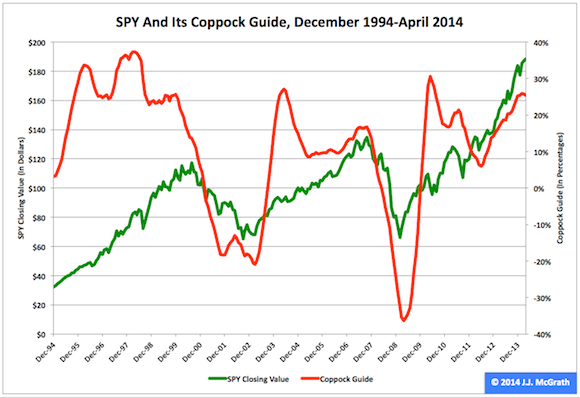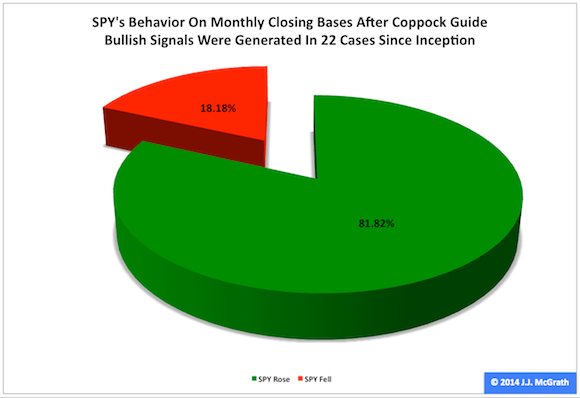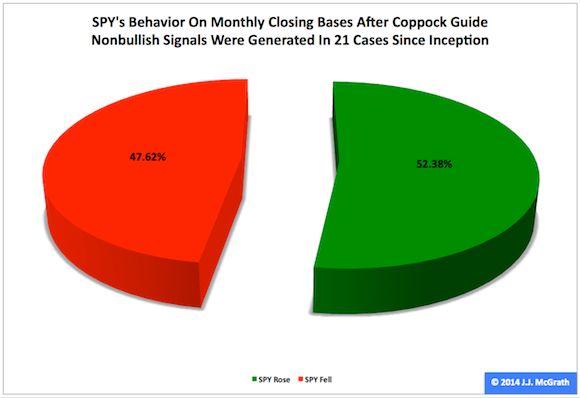The SPDR S&P 500 ETF (SPY) during the first four months
of the year ranked first by return among the most popular exchange-traded funds
based on the S&P 1500’s three constituent indexes, which also encompass the
SPDR S&P MidCap 400
ETF (MDY) and the iShares
Core S&P Small-Cap ETF (IJR).
Over the first third of 2014, SPY’s adjusted closing share
price rose to $188.31 from $183.88, a gain of $4.43, or 2.41 percent.
Meanwhile, MDY rose to $246.84 from $243.54, a gain of $3.30, or 1.36 percent, and
IJR fell to $107.13 from $108.82, a loss of -$1.69, or -1.55 percent.
SPY is the 12th of 13 ETFs featured in a J.J.’s Risky
Business blog series this month. Basically, I have been looking at each
ETF with both eyes fixed on its Coppock guide, as was the case in “SPY Coppock Guide: Away From Bullishness, Toward
Nonbullishness as of March 31, 2014.” The Coppock guide, aka either the
Coppock curve or the Coppock indicator, is a long-term indicator of price
movements in major stock-market indexes calculated on the basis of monthly
data.
Figure 1: SPY And Its
Coppock Guide, The Complete History
Note: The SPY
closing-value scale is on the left, and the Coppock guide scale is on the
right.
Source: This J.J.’s
Risky Business chart is based on
proprietary analyses of Yahoo Finance adjusted monthly share-price data and those data themselves.
Edwin S. Coppock built his long-term guide not to flash both
bullish and bearish signals but to generate only bullish signals. However, I
employ it to produce either bullish or nonbullish signals. It is extremely
important to keep in mind that a nonbullish signal is not equivalent to a bearish signal in the context of the guide.
I anticipate SPY may rise after a bullish signal and expect
it might do anything following a nonbullish signal (i.e., trade higher, lower
or sideways).
Figure 2: SPY’s
Behavior Subsequent To Initial Bullish Signals
Source: This J.J.’s
Risky Business chart is based on
proprietary analyses of Yahoo Finance adjusted monthly share-price data.
The SPY Coppock guide’s initial bullish signals collectively
have done an excellent job in forecasting the future upward movements of the
ETF on monthly closing bases. In 22 cases since December 1994, these signals
have been successful on 18 occasions, or 81.82 percent of the time, and
unsuccessful on four occasions, or 18.18 percent of the time.
The latest initial bullish signal flashed in June 2012, when
SPY’s closing share price was $131.18. Accounting for the one-month lag in the
confirmation of any signal, the ETF’s closing share price soared to $177.40 in January
2014 from $132.74 in July 2012, which clearly constitutes bullish action by any
standard.
Figure 3: SPY’s
Behavior Subsequent To Initial Nonbullish Signals
Source: This J.J.’s
Risky Business chart is based on
proprietary analyses of Yahoo Finance adjusted monthly share-price data.
In
contrast, the SPY Coppock guide’s initial nonbullish signals collectively have
done nothing in predicting any movements of the ETF on monthly closing bases.
In 21 cases since December 1994, SPY has followed these signals by advancing on 11
occasions, or 52.38 percent of the time, and declining on 10 occasions, or
47.62 percent of the time.
The most recent initial nonbullish signal was produced in February,
when SPY’s closing share price was $185.47. Subsequently, the comparable figures were $187.01 in March and $188.31 in April. Therefore, the
action in the market appears to have been pretty nonbullish to me, even though
it is still an open question as to whether the ETF will fall or rise on a
monthly closing basis in the wake of this signal.
Coppock Guide: The
Blog Series
Related Reading
Author’s Note: This is
the 12th blog post in a May series centered on the Coppock guides of 13
important ETFs, among them all nine Select Sector SPDRs and the most popular
funds based on the S&P 1500’s three constituent indexes. The first installment of the series was
cross-posted at both J.J.’s Risky Business and
J.J. McGrath’s Instablog on Seeking Alpha, but the rest of it is being posted here. You can follow me (and the
series) @JJMcGrath3000 on Twitter, at JJMcGrath on StockTwits and via myself on Google+.
Disclaimer: The opinions
expressed herein by the author do not constitute an investment recommendation,
and they are unsuitable for employment in the making of investment decisions.
The opinions expressed herein address only certain aspects of potential
investment in any securities and cannot substitute for comprehensive investment
analysis. The opinions expressed herein are based on an incomplete set of
information, illustrative in nature, and limited in scope. In addition, the
opinions expressed herein reflect the author’s best judgment as of the date of
publication, and they are subject to change without notice.



No comments:
Post a Comment